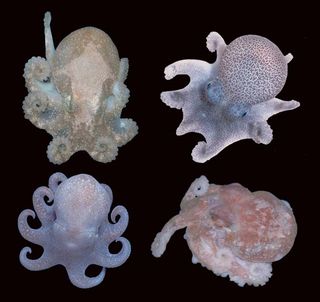Incredible Deep-Sea Discoveries Announced

An astounding batch of new deep-sea discoveries, from strange shark behavior to gigantic bacteria, was announced today by an international group of 2,000 scientists from 82 nations.
The Census of Marine Life is a 10-year project to determine what's down there. Among the new findings:
A large proportion of deep sea octopus species worldwide evolved from common ancestor species that still exist in the Southern Ocean. Octopuses started migrating to new ocean basins more than 30 million years ago when, as Antarctica cooled and a large icesheet grew, nature created a "thermohaline expressway," a northbound flow of tasty frigid water with high salt and oxygen content. Isolated in new habitat conditions, many different species evolved; some octopuses, for example, losing their defensive ink sacs — pointless at perpetually dark depths.
The finding will be reported Nov. 11 in the journal Cladistics.
Scientists also discovered what they're calling a White Shark Café: Satellite tags revealed a previously unknown behavior of white sharks traveling long distances each winter to concentrate in the Pacific for up to six months. During these months, both males and females make frequent, repetitive dives to depths of 300 yards, which researchers theorize may be significant in either feeding or reproduction.
In the eastern South Pacific, researchers found a diverse set of giant, filamentous, multi-cellular marine bacteria. They may be "living fossils" that developed in the earliest ocean when oxygen was either absent or much diminished, living on the toxic gas hydrogen sulfide, the scientists said.
Another survey found frequent examples of gigantism common in Antarctic waters. The researchers collected huge scaly worms, giant crustaceans, starfish and sea spiders as big as dinner plates.
Sign up for the Live Science daily newsletter now
Get the world’s most fascinating discoveries delivered straight to your inbox.
Among the other discoveries that will be revealed at a meeting this week in Spain:
- The first record of abundant and diverse comb jellies under Arctic pack ice .
- Surprising richness of species in many deep-sea locations, including the Celebes Sea in the southern Philippines and several deep canyons.
- At least 85 new species of zooplankton, small drifting and swimming marine animals.
Scientists estimate there are at least 1 million species of marine organisms on Earth. But as of now, only about 230,000 are known.
This is the fourth report from the Census of Marine Life since the project began in 2000. A final report will be issued in 2010.
"The release of the first Census in 2010 will be a milestone in science," said Ian Poiner, chair of the Census's International Scientific Steering Committee and Chief Executive Officer of the Australian Institute of Marine Science. "After 10 years of new global research and information assembly by thousands of experts the world over, it will synthesize what humankind knows about the oceans, what we don't know, and what we may never know – a scientific achievement of historic proportions."
- Gallery: Rich Life Under the Sea
- Rich Gallery of Deep-Sea Life Discovered in Bermuda Triangle
- Gallery : Small Sea Monsters
Most Popular


